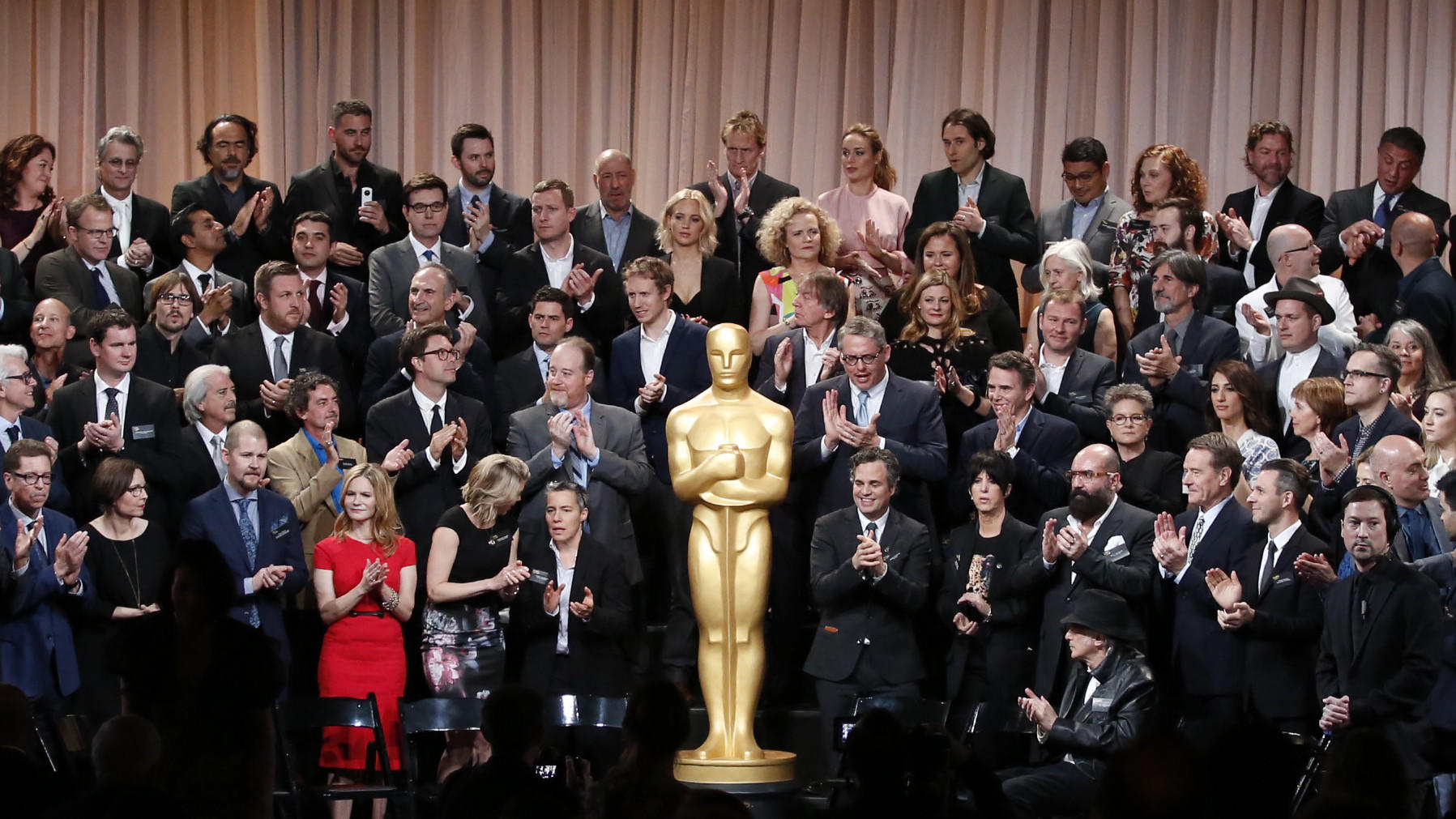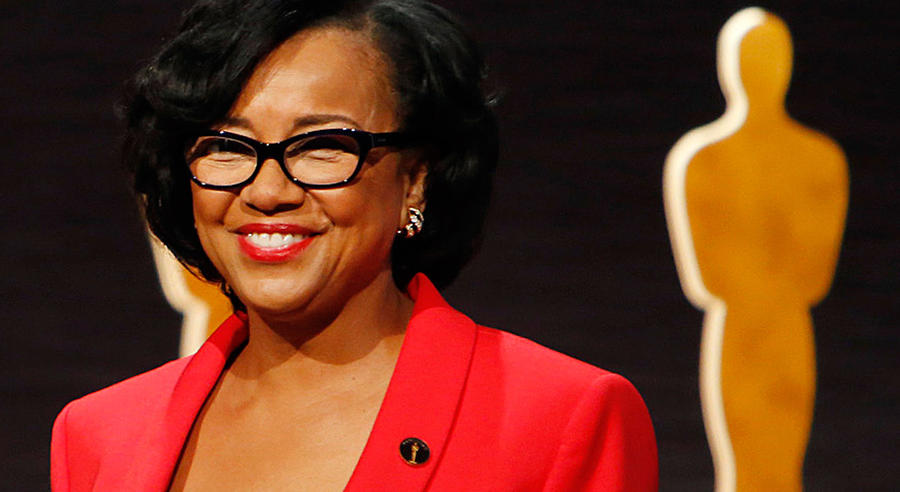
91% white. 76% male.
Changing who votes on the Oscars won't be easy.

With Sunday’s Oscar show, the Academy of Motion Picture Arts and Sciences will close one of the most contentious awards seasons in its history and open an era of historic change, as the 89-year-old institution launches an ambitious drive to diversify its membership.
A Los Angeles Times study shows just how much work the academy has to do if it intends to reflect the audience it serves — and just how aggressive the group’s new goals are.
In 2012, The Times reported that Oscar voters were 94% white and 77% male. Four years later, the academy has made scant progress: Oscar voters are 91% white and 76% male, according to a new Times study.
Blacks are about 3% of the academy, up from 2%; Asians and Latinos are each just over 2%, with both groups up slightly.
The academy has invited more women and minority group members over the last four years, but with its 6,261 voting members appointed for life, the organization’s ranks were on track to remain overwhelmingly white and male for decades.

Under fire for nominating an all-white slate of actors for two years in a row, the academy last month vowed to double the number of women and minority members by 2020. It also adopted controversial new rules that will allow it to take away voting rights from inactive members.
“Our goal is to make sure that we are active in bringing in different voices regardless of gender or race or sexual orientation,” academy President Cheryl Boone Isaacs said in an interview Thursday. “Inclusiveness in this organization, that is our goal.”
Doubling the number of women and minority members over the next four years, however, figures to be daunting.
The academy has about 1,500 women and 535 non-white people who are eligible to vote on the Oscars, according to Times estimates. Based on those findings, doubling their numbers would require inviting at least 375 women and more than 130 people of color each year.
That would demand a dramatic shift in admissions given that the academy's latest class — touted as the largest and most diverse in its history — was only 322 people, most of them white men.
Former academy president Hawk Koch says flatly that the targets are “impossible” to reach because of the academy’s stringent membership requirements and the underrepresentation of women and minorities in the entertainment industry.
“There aren’t that many qualified people, period, of any race or gender, to invite each year,” he said.
Boone Isaacs asserted that the goals are attainable.
“There are enough qualified people,” she said, adding that academy leaders will “do everything in our power to meet our goals because we know that this is the right thing to do. We’re going to make it happen.”
For years, the academy has declined to release a list of Oscar voters. In 2012, The Times identified nearly 90% of its membership, confirming each person’s race, sex and age through interviews, academy publications, resumes and biographies.

The new Times study updated that list by adding the more than 1,000 people invited to join in the last four years and subtracting several hundred others who have died. The resulting list includes more than 5,800 people, a few hundred short of the academy’s official count of members.
Though the academy did not participate in The Times’ research, a spokeswoman confirmed that the numbers are consistent with the organization’s own internal reviews of its membership.
In the wake of the 2012 Times story, the academy invited more women and minority group members. But when it announced its most recent Oscar nominations Jan. 14 and once again all 20 nominees in acting categories were white, the academy was faced with a firestorm of criticism and calls for boycotts of the awards telecast.
Director Spike Lee — who said he would not attend the Academy Awards despite being awarded an honorary Oscar last fall — echoed the complaints of many when he said the fault was less with the academy than with the gatekeepers in Hollywood who control what films are greenlighted for production.


Indeed, The Times’ review of the academy’s membership shows that the academy branches that hold the most power over Oscar season are the least diverse.
The executive branch, which finances the movies and determines what films warrant an awards campaign, is 98% white. The public relations branch, which strategizes those awards campaigns, is 95% white.
Other branches reflect the entrenched nature of certain hiring patterns in Hollywood crafts, such as visual effects, which is 98% male, and cinematography, which is 95% male.
The announcement of the new rules, which the 51-member board of governors enacted in an unscheduled, closed-door meeting Jan. 21, succeeded in quieting some of the criticism of the academy.
Some civil-rights groups are still planning to protest the show and encouraging those attending to wear black ribbons or armbands. Even so, the telecast producers have booked more than a dozen black presenters and performers, including Morgan Freeman, John Legend, Kevin Hart, Whoopi Goldberg and Quincy Jones.
Some in the industry applauded the academy taking such dramatic action.
“It’s not just an important conversation, but a necessary one,” said producer Jeremy Kleiner, co-president of Plan B Entertainment, the production company behind “12 Years a Slave” and “The Big Short.”



“Making systemic changes so that the body of the academy is responsive to changes in culture and changes in personnel is smart,” Kleiner added. “And, if you look at the statistics, overdue.”
But to reach its diversity targets, the academy will confront a major dilemma in drawing members from an industry in which women and minorities are scarce.
Each of the academy’s 17 branches has detailed requirements for membership under the group’s bylaws. Actors, for instance, must have three film credits, including one in the last five years. Directors need two credits, with one coming in the previous decade. Visual effects artists are required to have eight years of experience in a “key creative position” to qualify.
A recent report by the USC Annenberg School for Communication and Journalism described an “inclusion crisis” at studios, where 97% of film directors are male and 87% are white, where women hold just 21% of top executive positions and non-white actors garner just 27% of speaking roles.
Jennifer Warren, a 74-year-old actress and director who is a member of the acting branch and who chairs the Alliance of Women Directors, said the academy merely reflects an industry dominated by white men.
“It’s not the academy — it’s what the academy represents,” she said. “At least they recognize there’s a problem. And at least they’re embarrassed. I think that’s the only thing that will get movement in this industry is to embarrass individuals who are seen to have never hired a person of color or have never hired a woman.”
Although the academy’s new rules may have tamped down some of the criticism, they also sparked a rebellion among academy veterans, who say the institution’s leadership acted hastily and without hearing from members.
Some say the new rules, which now invite members for 10-year terms and require that they remain active in the film industry to retain voting rights, smack of another kind of prejudice.
“They’ve traded one perceived problem — racism — for another one, ageism,” said one longtime academy member who’s still working in the industry and did not want to be identified.
Boone Isaacs said she did not know how many people would lose their voting rights after the new rules take effect.
“We know how difficult it is to get movies made,” Boone Isaacs said. “The fact is that there are people who’ve been in this industry for a very long time who are still at the top of their form. This is a process. We are working this all out.”
The academy will need to dramatically increase the number of women and minorities it invites to join each year to meet its goal of doubling their numbers by 2020.
In March, Boone Isaacs and the rest of the board will meet to consider their next steps before the academy invites its next class of members later in the spring.

The academy itself might be refining some of its proposed changes. In an email obtained by The Times, academy membership coordinator Susan Allen wrote to actors branch member Carol Eve Rossen that the “process for evaluating whether a member will continue as a voting member is evolving.”
“Every possible aspect of the process is still under discussion, including the definition of ‘active’ and what the start date for involvement in the industry will be,” Allen wrote, referring to the proposed rule change provision that would require members to work in movies during three 10-year periods in order to retain their active status.

“Clearly, they have taken a step back from their knee-jerk reaction to nominations not to their liking,” Rossen, 78, told The Times. “The outrage of the mem bership has to do with loss of community,” she added, noting that many members who may lose their voting rights have long served on committees evaluating documentary and foreign language films.
“This year will tell a lot,” Koch said. “We’re not going to lower our standards. That’s what keeps the Oscars the Oscars.”
Times staff writers Kevin Crust, Marisa Gerber, Taylor Goldenstein, Ben Welsh, Amy Kaufman and Josh Rottenberg contributed to this report.
Graphics by Priya Krishnakumar. Graphics reporting by Sandra Poindexter. Interactive by Jon Schleuss and Armand Emamdjomeh. Design and development by Lily Mihalik and Evan Wagstaff.